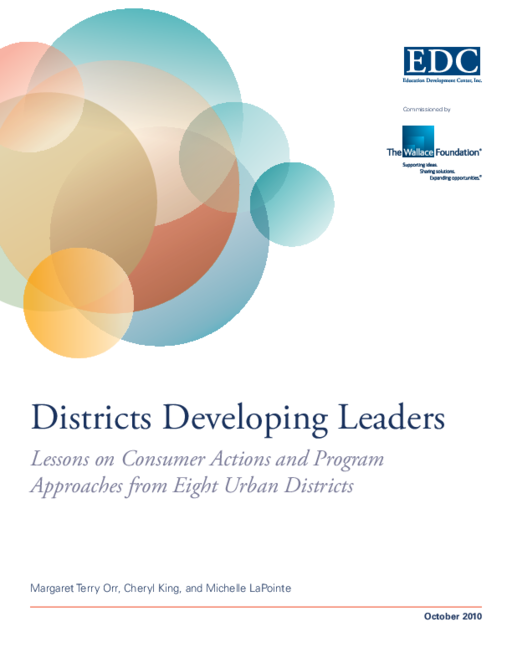Breadcrumb
- Wallace
- Reports
- Districts Developing Leaders Les...
Districts Developing Leaders
Lessons on Consumer Actions and Program Approaches from Eight Urban Districts

- Author(s)
- Margaret Terry Orr, Cheryl King, and Michelle La Pointe
- Publisher(s)
- Education Development Center, Inc.
Summary
How we did this
The primary data collection methods were a series of in-depth interviews of district and university officials and staff, and program participants; a review of program and district documentation; and administration of an online program features survey.
Many aspiring principals are ill-equipped to tackle the work awaiting them. This is because the university graduate-level school leadership programs that train principals too often fall short in giving them the skills and knowledge necessary. This report suggests a way out of this.
The study explores the investments of eight urban school districts in school leadership preparation. Specifically, it focuses on the different approaches that they took, the role that local universities played, and the perceptions of district officials about program effectiveness based on graduates’ performance as new school leaders.
As the chief users of what preparation programs supply—i.e., principals—districts have the power to grab the programs’ attention and demand better “products,” thereby stimulating better training, according to the study.
Key Findings
The report’s main finding is that the districts landed on three consumer-like approaches to promote higher-quality principal preparation:
- As discerning customers, districts defined what they were looking to “buy." This alerted university preparation programs to what the market was demanding. This meant that the districts established clear, rigorous standards for principals.
- Collaborators worked with selected universities to develop leadership programs centered on district needs. Often the districts that took this route offered modest financial incentives to make the collaborations more attractive.
- Competitors set up their own preparation programs to develop a pool of principal candidates.
Benefits
District investments in leadership preparation yielded both direct and indirect educational and organizational benefits.
Each district’s work resulted in leadership preparation that went beyond what the state required. The new training typically lasted longer than conventional preparation and placed more emphasis on matters important to school turn-around. For example, adept use of data to improve instruction. According to some school and district officials interviewed, new leaders from district-university affiliated programs were better-prepared and of better quality than those from other programs. In many cases, where evidence was available, these new leaders were perceived by district officials to be more effective, particularly in their instructional leadership ability, their capacity to transition well into leadership roles, and their understanding of school district operations.
The district efforts also saw the cooperating university programs adopt many of the features research has associated with sound principal preparation, such as rigorous admissions requirements, coherent curriculums, and high-quality internships.
Challenges
Districts had challenging school and leadership contexts.
A number of districts struggled to find the right balance between theory and practice in training, and to create a strong link between the new preparation and actual district hiring. And many districts failed to set up a mechanism to let the preparation programs know how their graduates were faring at work. This was an essential if these programs were to be tweaked and improved.
In addition, the researchers found that faculty members at universities unaffiliated with district efforts were not able to identify any changes that district programs had brought about.
Other notable challenges included high superintendent turnover that disrupted the efforts, uncertain future funding once foundation support ended, and a scarcity of experienced professionals to serve as mentors to the aspiring principals.

School districts need to recognize their power as the consumers of principal preparation program graduates, and the resulting influence they can wield in shaping these programs. By behaving as consumers, districts can improve the quality of program candidates and graduates, increase the number of qualified candidates for leadership positions, and ensure that program curricula address district needs.
Key Takeaways
- Districts can influence universities to revamp principal preparation by acting like “discerning customers” who clearly communicate criteria for the school leaders they want to hire.
- Creation and sustainability of programs required well-developed inter- and intra-organizational relationships.
- Feedback on graduates’ performance as school leaders is essential for both districts and universities to learn from their investments and to improve program quality and effectiveness.
- Full-time internships for aspiring principals were a critical strategy for preparing leaders, but the districts had trouble sustaining them once grant money ran out.
- States can promote better principal preparation by holding universities accountable for building state standards into their programs, toughening standards for training program accreditation with requirements for things such as minimum internship hours, and making sure requirements for principal certification are specific and encourage on-the-job training for newcomers.
Visualizations
Districts’ Consumer Approach to Leadership Preparation
Materials & Downloads
What We Don't Know
The study ended before the new principals had been working long enough for a good comparison of their effect on student achievement with that of peers from conventional training. The researchers were able to collect only limited, anecdotal evidence about how the new leaders were doing so far.

